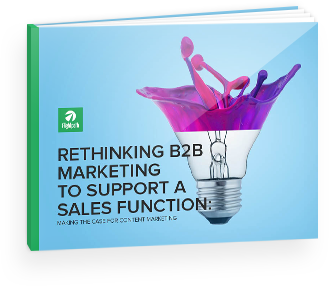They don’t understand the sales process well enough Marketing’s purpose in the past was to drive branding and awareness about the company and services. Brand recognition was enough for salespeople to get their foot in the door. But branding and awareness is tactic-driven—we’re going to do an ad campaign here, go to a trade show there, send out direct mail or emails this month, and so on. The rules of engagement have changed. People won’t tolerate the perception of being “sold to.” They won’t tolerate disruption unless it adds significant value. And they won’t talk to a salesperson until they’re good and ready. Because of this, simply making a larger investment in marketing tactics won’t get you where you need to go in the digital world.
The Fix: Sales and Marketing alignment
A strong sales culture with an emphasis on prospecting is still appropriate, but marketing’s role must be diverted away from tactics that create branding and awareness and more toward lead generation and lead intelligence for sales. Marketing’s focus in B2B companies should be to drive one-to-one conversations digitally, helping to supplement the sales person’s ability to prospect and qualify. That requires a flywheel of good content, just like publishing a magazine or newspaper. If your content stops, so do your conversations. That’s not a set of projects, it’s a new mindset.
They don’t know how to buy content services
Marketers know how to buy tactics, they know how to submit RFPs for website redesigns, branding campaigns, advertising spend, and trade show participation. But when they start moving away from tactics, many don’t know where to start. And to make matters worse, they’ve had bad experiences with outsourcing tactics to agencies in the past for the same reasons. Typically the agency wants to steer them in an area of their core expertise (tactic) — whether that’s SEO, advertising, or web development — as opposed to overall strategy, which is to fully understand the audience, why they are looking for solutions, and how to get content in front of them so that sales can get engaged in conversations they wouldn’t have known about previously.The Fix: Choose a digital marketing partner that understands the role of content in generating sales
When choosing a digital marketing partner to help you transition to content, the following capabilities are paramount:- An understanding of the role of content in the sales process.
- A well-rounded set of skills available in-house and fractional to the agency.
- Understanding of analytical measurements beyond branding and SEO.
- Examples and case studies of similar work.
- Superior research capabilities and an understanding of audience personas and how to map their buying journey.
They grossly underestimate the costs and work involved to create the flywheel
Gone are the days of publishing a few blog posts and having people find you. There’s so much content now, you’ve got to do better. That means more authenticity, more knowledge and more specificity. Remember, it’s about driving one-to-one interactions digitally and not about broadcasting a message to a broad audience and seeing what sticks. (That’s so last century.)The Fix: Commit
Again, content marketing is not about assigning tactics to marketing. It requires a constant diligence of understanding the reader, what their issues are, and how you can remain relevant. The consultative sales conversation is all about finding painpoints (and prescribing solutions) and so is marketing now. To get attention at the top of the funnel, you must focus on pain, pain, pain. I’m amazed at how many marketers say they understand this concept, but in practice defer to talking about products and services. One way to fix this is to put marketers through sales training where they’re taught to listen for pain points and only prescribe solutions when you get into a qualified conversation.They’re measuring the wrong things
I get asked a lot if content marketing will really work in B2B. The short answer is yes, but it’s not a magic bullet. The long answer is that just like any other successful initiative, the organization has to be committed to the long term, willing to make smart investments, align marketing and sales with a common goal of revenue growth, and above all, be willing to admit that what they’ve been doing in the past is not working. Marketers have traditionally cared about page views, average length of stay on the page, and conversions. All important, but these stats only give you insight at the campaign level. Again, we’re ultimately not trying to measure branding and awareness impact—we want to know how it impacts the ability of sales to get in front of more prospects and close more deals.The Fix: Measure conversions and track through the sales process
To know whether or not your marketing is having an impact, we need to be able to track how a lead becomes a sale (for the Schoolhouse Rock fans, that could be a good parody!) that will tell you where to invest money appropriately. Start by answering two questions:- Can you accurately measure your sales process now? In other words, where are your deals coming from now, and what percentage of them do you close?
Do you have the technology in place such as marketing automation and a CRM, and do your sales people actually use it?
If you’ve answered yes to both of those questions, then it should be relatively easy to track some significant numbers that will tell you exactly where to spend money and what needs to be fixed. For example, if you’re generating plenty of leads every month, and the statistics show that you should be closing X number of deals, but you’re not, you’ve got a sales problem. If you’re closing a large majority of leads that come from various sources, but you don’t have enough “at bats” to move the revenue forward, you’ve got a marketing problem. And the measurement can even get more granular. You should be able to add up all of the money you spend on marketing and sales people, divide it by the number of customers you got that year (your customer acquisition costs), and then determine based on how many leads you generated, how much each one of those cost you (and what it’s worth to you). Content marketing done correctly should be completely measureable, giving you the ability to know where you’re going to have the best return on investment.





